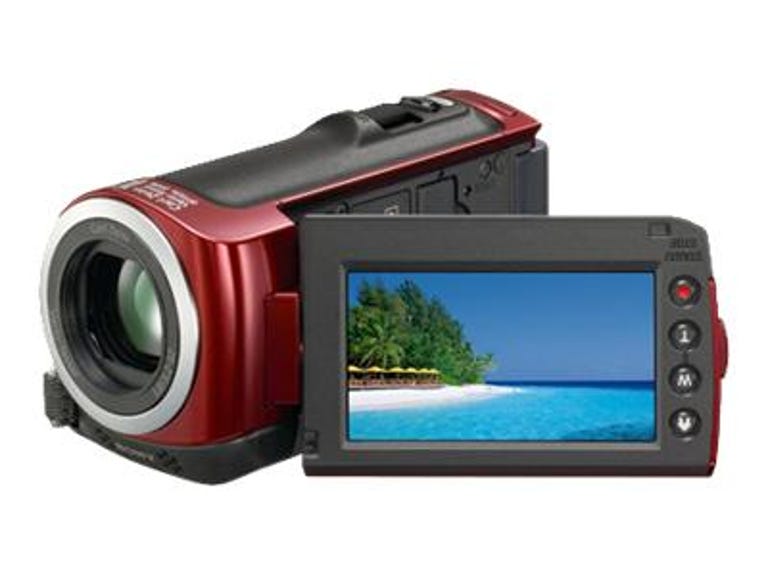The Good
The Bad
The Bottom Line
Sony's first attempt to produce an HD camcorder for less than $600 is a bit of a mixed bag. Like all its competitors, the company has driven its flash and hard-disk HD development in two directions: one road leads to compact and less powerful models, the other to larger but better equipped products. The Handycam HDR-CX100 is the first of Sony's AVCHD models to head down the budget path. And with it comes the inevitable question: how much of a sacrifice in video quality and usability are you willing to make for size and price?
With dimensions of 2.3 inches by 2.4 inches by 4.5 inches and weighing 11.7 ounces with battery and Memory Stick Duo, the CX100 certainly qualifies as compact for its class. Though it's no diminutive minicamcorder, it fits quite comfortably in a jacket pocket, and it has a lot of things those models lack, including a 10x zoom lens and the ability to capture 2-megapixel (or 4-megapixel interpolated) stills. I like the look of the CX100. Though it's a bit boxy, it nevertheless has clean lines and the combination of a solid heft plus textured matte and glossy plastics keep it from seeming cheap. It comes in basic black, traditional silver and my favorite, bright red.
But while it's pretty enough to look at, I found the CX100 a bit uncomfortable to shoot with. Unlike its older, more expensive sibling, the CX12, the top is relatively flat, which makes it difficult to grip while managing the zoom switch and photo buttons; you have to really squeeze with your back fingers to keep the camcorder from moving. Shooting stills required two hands: one to hold the camcorder and the other to press the shutter. The 2.7-inch LCD is small, which is understandable given the unit's size, but it's hard to view in direct sunlight and through all those fingerprints the touch screen accumulates.
It has the usual set of buttons: direct DVD burn (via software when connected to a PC), playback, Power, display info, and full-auto Easy on the body inside the LCD, and Home, zoom, and record buttons on the LCD bezel. The buttons are very flat, but good enough. Beneath doors in the same location you'll find the Memory Stick Duo slot (any Pro Duo or better works fine) and USB and mini-HDMI connectors; the charging connector and proprietary AV jack are under a door on the outside of the body. To the right side of the lens is a switch for the built-in lens cover.
The menu system can be quite frustrating. Though the touch screen is for the most part sufficiently responsive, the menus are structured in such a way that it's almost impossible to remember where to find some of the settings. Under the Home menu you can choose from the three basic capture modes--movie, photo, and Smooth Slow Record (for example, to record golf swings)--though the mode switch lets you choose between movie and photo. Under this menu is also a tab for image-viewing options; Others, which are random options for in-camera editing, and TV and USB connections; Manage Media, which is where you choose whether to record to the internal 8GB of memory or to a card; and Settings for options like SteadyShot stabilization, selecting high def or standard def, face detection and Smile Shutter, and Output settings (for example, TV type and HDMI resolution). Under the Options menu you'll find more shooting related settings, including spot meter and focus, manual focus and exposure, white balance, scene modes, and recording quality (bit rate). So while you select Movie Settings in one spot on the Home menu, and standard versus high def elsewhere on the Home menu, you select movie quality in the Options menu.
At its highest quality, the 16-megabit-per-second mode, you can record almost 7 minutes of video per gigabyte of storage. That's about 55 minutes in the internal memory. If you drop to 9-megabit-per-second mode, that increases to about 10 minutes per gigabyte.
With the exception of the face detection, Smile Shutter, and scene modes, the camcorder has no bells or whistles to speak of. That's not necessarily a bad thing, but it could use a wind filter. The company dropped the NightShot infrared mode for this model; I doubt it was very popular, but I found it useful in emergencies. It forgoes Sony's usual 5.1-channel surround in favor of more typical 2-channel--no great loss there.
The CX100 incorporates Sony's 1/5-inch 2.4-megapixel Exmor ClearVid sensor, and the quality sensor really shows in the low-light shooting; though you probably wouldn't like the results from your latest pub crawl, video shot in your living room should look quite good thanks to the on-chip noise reduction. In other ways the video quality is typical of a lower-cost model. In bright sunlight there are frequently blown-out highlights, colors are attractive and saturated but some--like deep red roses--are off. The image stabilization works fine in tandem with the reasonably long 10x zoom lens. When viewed on a large-screen HDTV I noticed some smeary edges, though the video generally looks sharp enough. The lens focuses pretty quickly, but it could really use some better coatings; it displays serious lens flare from bright light coming in at oblique angles.

Given the widespread availability of better but larger older models from Sony and other manufacturers whose prices have dropped significantly, the real buying decision you make with the Sony Handycam HDR-CX100 is how much size matters to you. And even if you want it as small as possible, you should probably check out competitors like the Canon Vixia HF100 before committing.



